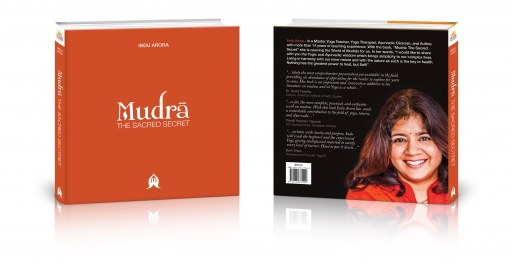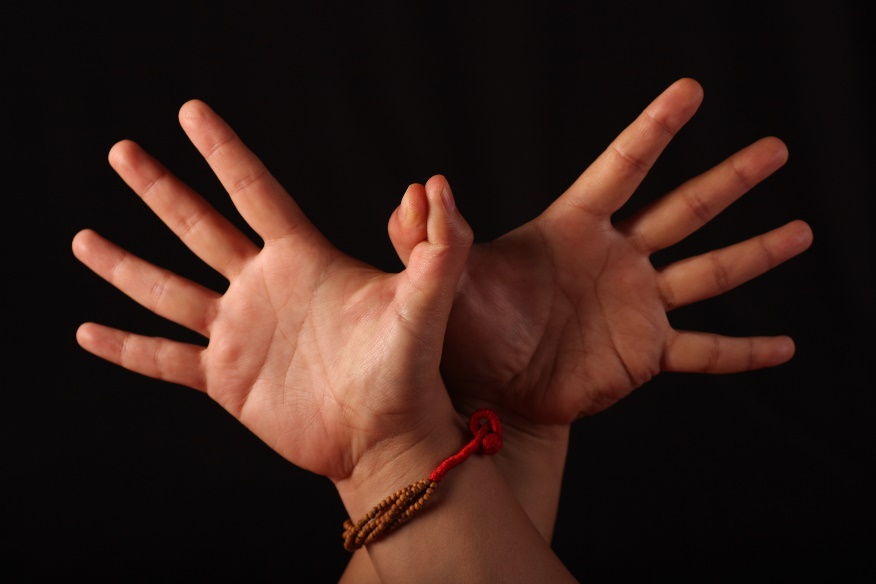
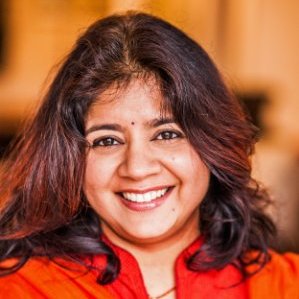 You have written a beautiful book called Mudra: The Sacred Secret. Can you explain what Mudras are?
You have written a beautiful book called Mudra: The Sacred Secret. Can you explain what Mudras are?
Mudras are systematic hand, body and face gestures that create “closed electrical circuits” of the subtle channels of the physical and energy bodies. The word “Mudra” comes from the root word, “mud,” which means to impart bliss. The Mudras in my book are hand Mudras, or, gestures, which are based on the connection of each finger to a lobe of the brain. The use of Mudra is a gentle practice that can benefit everyone. This practice is especially very important for people dealing with cancer.
Why is the practice of Mudra so important for people with cancer?
The most important aspect of the approach to yogic therapies for someone with cancer is to avoid the activities that burn energy of the body as it is already so depleted from the treatment. You want to maximize the energy without using the energy of the body. Most cancer treatments burn, or use, the energy of the body. They have very debilitating effects and it depletes the nourishment of the body, taking away prana, or life force energy. From the yogic point of view, all forms of healing, therapy and treatment are nothing but maximizing of the prana. Mudras are an almost effortless way to maximize the prana.
The other thing we want to do in yoga therapy is to increase ojas, which is one of the three vital essences (the two others are Prana-Energy/life and Tejas-Radiance/ light) and it represents the strength and the immunity of the body. Cancer treatments can deplete the body at a very substantial level and the body doesn’t have the capacity to convert food into ojas, which is the essence of all the tissues.
Mudra works not only at the subtle level, but at the physiological level as well. What we want to accomplish is to increase the healing capacity of the body, to improve the intra- and extra-cellular communications, to facilitate the draining of the toxins and the metabolic wastes, to improve the blood circulation and to improve the cellular restructuring. Mudra can help to support all of those functions.
Can you further explain the vital essences and how Mudra benefits them?
Our energies are actually a trinity of the three vital essences. We have prana — the life force, tejas — which comes from the agni — the digestive fire, and ojas. These three vital energies are the main triangle upon which the health of the mind and body rest. Mudra is just another tool that we use in yoga therapy to balance these energies.
Prana is the lighter energy of the body related to the air element, relates to circulation, the nervous system and communication. Tejas is the energy of the element fire and includes the metabolism, concentration, focus and intelligence. Ojas is the energy of stabilization, grounding, nurturing, nourishing of the tissues and strengthening the immunity.
Specifically in cancer and cancer treatment, the digestive fire is low and the appetite is affected, so that is the tejas aspect. The immune system goes low and that is the aspect of ojas. The blood circulation is affected and there is dryness in the body, and that is prana aspect. So all three vital essences are affected by cancer treatments as well as the cancer itself.
In the yogic viewpoint, we have to look at both the person and the condition. These three essences will be low in order for the cancer to be activated in the first place. But the burning nature of the radiation and chemotherapy treatments further depletes the prana, ojas and tejas, both during the treatment period and for some time afterward. So, the Mudras can help to reverse that process. The prana Mudra would be the basic Mudra for helping to build the prana in the body. It is a wonderful Mudra for bedridden people, as it provides them with strength and energy.
Mudras are wonderful tools because unlike many therapies, they are accessible to people who are feeling weak or fatigued. Are there any general recommendations that you have for incorporating Mudras for those in cancer treatment?
When someone is in cancer treatment, there are Mudras that can be done that both make the body receptive to the treatment, as well as to protect the body from the negative effects of the treatment.
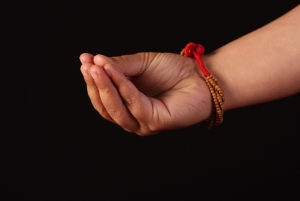
Figure 1: Samana Mudra
One of the main Mudras to make the body receptive to treatment is the Samana Mudra. Samana Mudra is related to the Samana vayu, one of the five prana vayus, or the movements of the life force energy. Samana vayu governs the function of assimilation, so it makes helps the substance being introduced into the body become like the body, and the body becomes receptive and makes space for the treatment in the body.
This Mudra can be done prior to the infusion date, or literally during the treatment session.
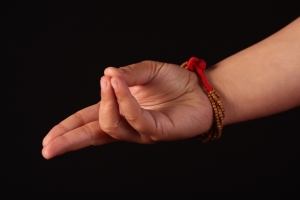
Figure 2: Prana Mudra
The Prana Mudra is best to do after the treatment to help the body to recoup the energy of the body and to absorb the energy or the medicine into the body at the cellular level.
Cancer treatments typically deplete the body, because it assumes a lot of energy, so the prana Mudra helps with absorption at the cellular level as well as with lifting the energy level.
How often should we practice the Mudras, and how long should the Mudras be held?
Every practice in yoga creates a certain rhythm in the body, with effects that last for a certain length of time. That is why it is suggested that physical practice, or asana, should be done once in 24 hours. The pranayama, including the breathing techniques, should be done four times a day.
Ideally, each Mudra should be done three times a day, as the effect will stay with the body for 6-8 hours. So, we can say, morning, afternoon and evening.
The Mudras need to be held for a minimum of two minutes. It takes 30 seconds to just “ignite” the Mudra, to create the electromagnetic circuit. Then, it needs to be held for at least two minutes, but you can hold it for as long as can, ideally for 45 minutes in a 24 hour period, so, again, morning, afternoon and evening.
You can do it for as long as you enjoy it, because your body has its own intelligence as to how much energy or electricity that it can digest at a point and the fingers will release on their own.
What body position should we hold when we practice Mudras?
We typically use the meditative seated postures, but the Mudras can also be done in a chair or lying done. The main thing is that the spine is straight and the chest is open. The use of Mudra in other asanas is only done to create “photograph-asana” (laughs).
Is there any way to overdo the practice of Mudra?
No, the body will release the movement or communicate in other ways if it is too much. So, you have to be mindful that if you notice any discomfort, including nausea, heartburn, dizziness or headaches, then that is a sign from the body to release the Mudra. You should stop doing it and try it again later. If the same symptoms appear, then this Mudra is not being accepted by the body, so you need to change and to try another Mudra. There are so many other Mudras to try.
What other Mudras do you recommend during cancer treatment?
There is a category of Mudras called the sparsha Mudras, which are the therapeutic Mudras of touch. Here you place your hands on the areas of the three lobes of the lungs, one by one. You then do the breathing by balancing the inhalation and exhalation. You breathe three-dimensionally, into the front, side and back of each area: the lower, middle and upper lobes of the lungs.
The lower lobes of the lungs allow you to circulate the prana in the lower three organ systems: the digestive system, the reproductive system, and the excretory system, as well as into the legs.
The middle lobes of the lungs help to channel the prana into the digestive system, the respiratory system and into the circulatory system of the blood.
The upper lobes of the lungs direct the prana into the nervous system, the brain and the sensory systems.
This practice of touch is associated with the air element, and when the air element is disturbed, it becomes vata dosha (one the three mind/body “defects”). Vata dosha exhibits itself as restlessness, anxiety, fear, a sense of insecurity, dryness, constipation, poor or variable appetite, bloating and headache. These are all symptoms of vata being out of balance, and touch is one of the finest ways to calm down the vata dosha.
These sparsa Mudras are also extremely beneficial for grounding, for bringing that sense of self-connection in times of stress and ungroundedness. This practice is extremely powerful at so many levels. In my book, I demonstrate the use of the sparsa Mudras for the three lobes of the lungs combined with pranayama.
Can you explain how this Mudra affects the flow of prana?
There is a verse in one of the yogic texts that is “drishti manaha prana.” Drishti means your gaze or focus, your awareness. Manaha means mind — your sensory mind, and prana is energy. So, what it means is that, “wherever your focus, energy and your vision goes, your mind goes, and where ever your mind goes, the prana follows.”
So, by placing your hands with a sense of touch, your awareness goes, your focus goes, to a specific lobe of the lung and the mind follows. As the mind follows, the prana follows the mind. So it “pranafies — if there is word like that — that part of the lung, which in turn brings the prana to connected parts of the body. A person can do the practice for a specific lobe associated with a specific organ, or they could do it for all three.
For example, if someone had breast cancer, that would be the middle lobe and for prostate cancer it would be the lower lobe. The throat and the brain would correspond with the upper lobe of the lung. It makes sense to want to target a specific organ, but we have to remember that whatever is happening in one cell, there is a ripple effect in the whole body. So, it is suggested to do all three lobes. But if someone only has time for one, it is okay to choose the lobe associated with the affected area.
Why is the practice of Mudra so beneficial to someone who is in a fatigued or weakened state?
It is a practice that one can do even lying down. For someone with cancer or in cancer treatment, being in a seated position for long periods of time is not something that is suggested or that could be easily accomplished. It takes so much core strength, flexibility of the joints; focus and concentration to stay in a cross-legged seated position, so these Mudras can be done lying down on the bed, or seated in a chair. There are many different options.
This is not so much only the issue of someone having cancer or not, but for me, just common sense — if I can maximize the prana by minimal use of energy in the body, why would I not do that? Why would I unnecessarily expend energy to gain energy in the body? If I can spend one unit of energy and make four units of energy, I would choose that.
How much energy should a person put into their physical yoga practices?
In the Ayurvedic texts, it is written clearly that the amount of physical practice one should do is “ardha balam,” which means half the capacity, or half the strength.
I’ve seen people really sweating and working out in yoga, using 200% of their strength, as though the more you sweat, the more you relax. But that feeling of tiredness is not the relaxation of the body, it is the recouping of the body’s strength.
We have a tendency to be harsh on ourselves and our bodies, but yoga doesn’t work that way. Yoga is not a work out, it is a work in. We have internalize, to contemplate, to turn inward and to be insightful.
If there is any flexibility required in yoga, it is of the mind. If there is any strength required in yoga, it is of willpower, focus and concentration. In the West, we tend to externalize everything. I would say this is not just a suggestion for people dealing with cancer. It is a question of common sense and understanding the philosophy of the practice.
Is there a specific Mudra that you suggest for dealing with depression?
Depression is generally related to the earth and water element, heaviness, sense of inertia, passive, inert, laziness. This is more related to tamas, or darkness.
The Mudra that works in this case awakens the energy, bringing the light, is called simha Mudra — which means the lion gesture. Simha is also a pose with the body, the Simha asan, but what you do in the pose makes it a Mudra.
This Mudra be done standing or seated, even in a chair, with the hands on the thighs and the fingers spread wide.
You sit up straight and open the mouth wide, extending the tongue to the maximum out and down toward the chin, with your chin parallel to the floor. Then roll your eyes up toward the center of the eyebrows. So, the tongue goes down and the eyes roll up, creating a 90 degree angle at the back of the ears. This helps to open the circulation to the brain and to the heart. Then, take a deep inhalation into the nose and exhale through the mouth, creating the sound, “ha,” saying it as strongly and clearly as you can.
Before you do it, you can set the intention to draw all the negativity and tamas into the region of the navel, because the navel is the seat of fire. The intention is the tamas is consumed by the agni, the fire, in the navel area. The sound of “ha” is the sound of release, the sound of letting go, the sound of opening up. The sound of “ha” comes from the tailbone. In yogic understanding, the spine is compared to a musical instrument and every chakra is associated with a specific vibration and a specific sound or syllable. So, the more clearly one can say “ha,” the more open the entire musical instrument becomes. At times it is very surprising how difficult it can be for people to release this sound.
The best time to do this Mudra is in the morning or on an empty stomach because it really churns the abdominal region.
Would this Mudra work if someone is both depressed and anxious?
Yes, this is still very beneficial because this connection comes from the heart. The heart is the seat of the air element in the body when we talk about chakras, the seven main energy centers along the spine, which are each associated with a specific element.
The tongue is considered both a sensory organ and an organ of action, so it is the bridge between the mind and the body. When you extend the tongue and release, you are releasing not only the organs of action, but the organs of senses, so wherever there is an imbalance, it addresses that.
It is said that the tongue has a direct connection to the heart. So, it really is very calming for both depression and anxiety.
Are there other Mudras that you recommend specifically for anxiety and depression?
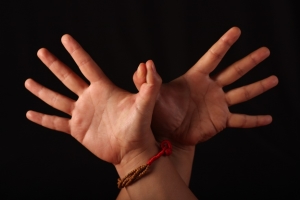
Figure 3: Garuda Mudra
Yes, the eagle gesture — not the body, but the hand eagle gesture — Garuda Mudra. This is specifically beneficial to work on the thyroid and the chest region, on the thymus as well. But its main function is to move the stagnation of fluids in the body. Depression is a stagnation of the earth and water element, which further depletes the metabolic function of the body. The digestive system is definitely one of the organ systems affected by both anxiety and depression.
So, this is Mudra that helps with immunity, but it also lifts up the fire element, which is good for both moving the stagnant earth and water, and also to warm up the excess dryness. Because vata creates dryness, and that is associated with anxiety. Warmth creates lubrication. Besides helping with mood fluctuations, this Mudra is highly beneficial for cancer, especially for breast cancer and for increasing lymphatic drainage.
The Garuda Mudra can be done any time of day and it should be done on an empty stomach, and should not be done by those with high blood pressure.
Should all Mudras be done on an empty stomach?
Not necessarily. Some Mudras are specifically done after a meal to help with digestion — to redirect the blood flow to the abdominal organs, which aids in digestion.
You mentioned that the Garuda Mudra helps with removing the stagnation of fluids in the body, so is that a good Mudra for lymphedema?
It could be a very good Mudra for lymphedema, but there is another Mudra, called the Varuna Mudra that is specifically for lymphedema. To do this, the pinky finger folds toward the center of the palm, keeping the other three fingers comfortably stretched out and you press the top (the second phalange) of the pinky finger with the thumb pad, as though you are pressing the pinky finger down into the center of the palm.
The pinky finger controls the water element, so if we wanted to harmonize or increase the circulation of the water element in the body, then we would press the thumb pad with the pinky finger pad. But here, instead we want to decrease, drain or remove this excess fluid accumulation from the body, so we would reverse this gesture by folding the folding in the pinky finger and pressing it in toward the palm with the thumb. This would be a more direct Mudra for lymphedema because it deals directly with the water element.
This Mudra should not be practiced in case of dry cough.
Is there any Mudra that you would recommend for grief, either for the loss of another person or of an aspect of themselves?
Grief is a very important in a person’s life and there are stages to it. It is a process and it should not be fast-forwarded. Something can be of support going through a phase, but grief is not a condition, unless it is prolonged and affects the activities of daily living.
There is a practice that can be helpful, a Mudra of the eyes called Trataka, in which you gaze at flame, just a tea light candle, about 4-6 feet away, at the level of the eyes, without blinking. The main purpose of this is to balance the hormonal functioning of the pineal gland, which is photosensitive. It is also a Mudra of concentration. It triggers the parasympathetic nervous system and therefore the relaxation response. We usually fight our emotions rather than accepting them, which is where the main conflict starts. The parasympathetic nervous system allows you to be relaxed, okay to be comfortable and to accept what is going on in the body and in the mind. So, although it helps us to build focus and concentration, which will help us to stay centered and not scattered, but in turn it triggers the parasympathetic nervous system. It is a very unique practice.
If the flame is 4-6 feet away, there is no harm to the eyes in gazing at it?
No, you want it to be a very comfortable, relaxed gazing directly at the level of the eyes, so there is minimal pressure on the eye muscles to focus. If someone wears glasses or contacts, they should continue to wear them for the gazing. One should not use aromatherapy candles as the essential oils or any other chemicals create uneasiness since the eyes are kept open deliberately.
Would Apana Mudra also to be good help release toxins and excess fluids in the body?
Apaan Mudra helps in releasing all kind of toxins out of the body. It awakens the body’s innate intelligence to let go of anything that does not serves the purpose of health. However, it should not be practiced during pregnancy.
Would Pusan Mudra be good for nausea after chemo?
Pushan Mudra increases heat in the body. I would suggest the practice of Prana Mudra for nausea post chemo.
Is there a suggested Mudra for chemo-induced peripheral neuropathy?
I would highly recommend the Spasha Mudra and the Hakini Mudra for the chemo-induces peripheral neuropathy as both of them work on nerve endings to awakens body’s intelligence thought the balance and strengthening of the nervous system.
Are there any other precautions or recommendations that you have regarding the use of Mudras?
Just listen to your body, it will tell you what you are enjoying. It should be done with the intention of enjoying the practice and not in a robotic way so that you can check off a box on your to do list. It is better to do it once a day and to really enjoy the practice. We have a tendency to time things, so don’t do it with that attitude. Really enjoy the practice and let the intelligence of your body guide you. I truly believe that, “Nothing has the greatest power to heal, but Self”. The body has the innate power to heal itself, we just need to allow and open up.
I like that the word for health in Sanskrit is svastha, meaning to be established in the self.
Yes, established in the Self, to be at home. The beauty of the Sanskrit is that these are not just words, but philosophies. The concept of Self and home is missing in the West. To be grounded in the Self, to be at home with the Self, to be established in the Self, then the wisdom of the body awakens and guides you. That is the yogic concept of healing.
Where can people get in touch with you and where can they find your beautiful book, Mudra, The Sacred Secret?
I can be contacted at my website, www.yogsadhna.com. My book is available there, as well many other resources to help bring balance and radiance to your life.
Thank you so much for generously sharing your time and knowledge with us.
You are very welcome. My mission is to share the yogic and Ayurvedic wisdom, which brings simplicity to our complex lives.
For more information on Indu Arora, Ayurvedic Clinician & Yoga Therapist, Teacher & Director of Yogsadhna, go to http://www.yogsadhna.com, call Indu Arora at 630.219.0054, or email her at drinduarora@yogsadhna.com.

